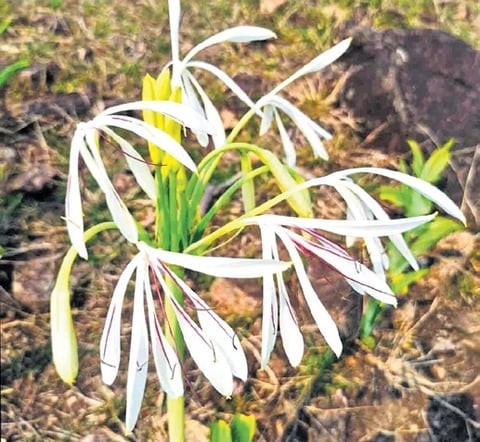Walking pneumonia
In recent weeks, doctors have sudden increase in reported cases of walking pneumonia.
- Walking pneumonia is most commonly caused by the bacteria Mycoplasma pneumonia.
- Walking pneumonia, also known as atypical pneumonia, is a less severe type of pneumonia.
- It is a mild yet persistent lung infection that can mimic symptoms of a common cold.
- The primary difference between them is that the common cold is usually caused by a viral infection while walking pneumonia is essentially a bacterial infection.
- Unlike typical pneumonia, which can lead to severe lung inflammation and difficulty breathing, walking pneumonia is often less intense, allowing people to carry on with their daily activities.
- It is also called 'silent' pneumonia because sometimes people don't experience symptoms despite X-rays showing fluid-filled air sacs in the lungs.
- Symptoms - Fever, Runny nose, Cough, Sore throat, Headache, Tiredness, Ear pain, and Chest pain from coughing.
- Transmission - Though walking pneumonia is typically not as contagious as the flu or a viral cold, it can still spread through respiratory droplets when an infected person coughs or sneezes.
- Vulnerable - People who work or live in crowded spaces are at a higher risk of outbreaks.
- Prevention - There aren’t any vaccines available that prevent walking pneumonia.
- Treatment - Walking pneumonia is often manageable with rest, fluids, and, in some cases, antibiotics.
Reference
India Today | What is walking pneumonia?
Crinum andhricum
Botanists have discovered a new species of flowering plant, ‘Crinum andhricum’ in the Eastern Ghats of Andhra Pradesh.
- Family – Amaryllidaceae.
- It is the latest addition to India’s Crinum species, bringing the total to 16.
- Nomenclature - The species was named after Andhra Pradesh in recognition of the State where it was first found.
- Genus – Crinum, several being endemic to India.
- It has unique characteristics that set it apart from other known species in the ‘Crinum’ genus.
- The plant is closely related to two species, Crinum amoenum and Crinum stracheyi but differs in key ways.
- Uniqueness - Crinum andhricum has distinct features, including
- Wider, oblanceolate perianth lobes (the outer part of the flower) and
- A greater number of flowers per cluster-producing between 12 and 38 flowers in each.
- It also noted that the plant’s pedicelled flowers (with a stalk-like structure) make it unique among species in the region.

- Habitat - It was found growing in the dry, rocky forests of the Sapparla hills.
- Appearance - The flowers of Crinum andhricum are waxy white, blooming between April and June.
- The tall stem that reaches up to 100 cm. The leaves are large, elliptic, and have smooth, entire margins, features.
- Conservation status - The researchers have given Crinum andhricum a preliminary status of ‘Data Deficient’ under the International Union for Conservation of Nature (IUCN) guidelines.
- Threats - Forest fires and grazing.
Reference
New Indian Express | Crinum andhricum
Sukhna Wildlife Sanctuary
The Union ministry of environment, forest and climate change recently issued a notification demarcating an area of 1 km up to 2.035 km around the Sukhna Wildlife Sanctuary on the Haryana side as an ESZ.
An eco-sensitive zone (ESZ) is an area surrounding protected areas like national parks and wildlife sanctuaries that require special protection due to their rich environmental resources.
- The Sukhna Wildlife Sanctuary spread over 25.98 square km in the North-East of Sukhna Lake.
- It is under the administrative control of the union territory of Chandigarh.
- It shares its boundaries with Haryana and Punjab.
- The sanctuary is located in the Shivalik foothills, which are considered ecologically sensitive and geologically unstable.
- The soil in the Shivaliks is sandy, embedded with pockets of clay which is highly susceptible to erosion by surface run off.
- Recent Notification - The prohibited activities include commercial mining, stone quarrying, crushing units, sawmills, industries causing water, air, noise, and soil pollution, commercial use of natural water resources including groundwater, wood-based industry, etc.
- Among the regulated activities, no new commercial hotels and resorts shall be permitted within zone 1 and 2 except for accommodation for temporary occupation of tourists related to eco-tourism activities.
- However, the local residents shall be permitted to undertake construction on the land for their bona fide residential use.
- Sukhna Lake - It is a man-made, rainfed lake, constructed in 1958 by damming the Sukhna Choe, a seasonal stream.
- The lake was designed by the creator of the city, Le Corbusier, and the plan was executed by the then Chief Engineer, P L Verma.
- The Lake is declared as a National Wetland in 1988.
- In sixties & early seventies, the rate of siltation of the lake was very high due to high rate of soil erosion from its catchment area.
- Upto 1988, 66% of the original water holding capacity of the lake was lost due to siltation.
- The lake is home to several species of migratory birds.

Reference
Hindustan Times | Sukhna Wildlife Sanctuary
Colors on Birds
New studies advance the understanding of how birds produce their colorful displays and how these traits have evolved.
- Nearly all birds with bright red, orange, and yellow feathers or bills use a group of pigments called carotenoids to produce their colors.
- However, these animals can’t make carotenoids directly. They must acquire them through their diets from the plants they eat.
- Parrots are the exception to this rule, having evolved an entirely new way to make colorful pigments, called psittacofulvins.
- Recent Findings - Researchers used recent advances in genetic sequencing to examine which regions of the genome determine natural yellow-to-red colour variation in parrots and finches.
- Findings in Dusky lory (Pseudeos fuscata) –It is a parrot native to New Guinea with bands of feathers that may be coloured yellow, orange or red.
- The research found that shifts between yellow and red feather colouring were associated with an enzyme called ALDH3A2.
- This enzyme converts red parrot pigments to yellow ones. When developing feathers contain large amounts of the enzyme, they end up yellow; when they have less, they end up red.
- Findings in long-tailed finch (Poephila acuticauda) – It is a species of songbird native to northern Australia.
- There are two hybridising subspecies with different colored bills. One is yellow-billed while the other is red-billed.
- The bill color in these finches was mostly linked to two genes, CYP2J19 and TTC39B.
- Together, these two genes drive the conversion of yellow dietary carotenoids to red ones.
Reference
The Hindu | Special genes, known for coloration
Pinaka multi-barrel rocket launcher (MBRL) system
A senior French Army officer recently revealed that France is evaluating India’s indigenous Pinaka multi-barrel rocket launcher (MBRL) system for potential use by its military.
- It is a long-range artillery system capable of striking targets upto 75kms away.
- Developed by – Defence Research and Development Organisation (DRDO).
- The system has multiple variants, which offer flexibility in terms of payload, firepower, and range.
- Features - It provides a unique capability to accurately deliver a devastatingly lethal and responsive fire against a variety of area targets such as
- Exposed enemy troops,
- Armoured and soft skin vehicles,
- Communication centres,
- Air terminal complexes,
- Fuel and ammunition dumps.
- The system consists of Rocket, Multi Barrel Rocket launcher, Battery Command Post, Loader cum Replenishment Vehicle, Replenishment Vehicle and Digicora MET Radar.
- It is capable of firing in salvo mode within 48 sec neutralizing the area of 700 x 500 m.
- This versatility makes it suitable for different types of military engagements, such as counter-terrorism, border defence, and conventional warfare.
- Armenia has placed orders for the system earlier.
Reference
Times of India | What is the Pinaka?

